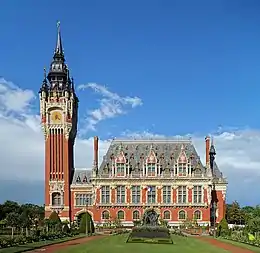| UNESCO World Heritage Site | |
|---|---|
 Calais City Hall | |
| Location | Calais, France |
| Part of | Belfries of Belgium and France |
| Criteria | Cultural: (ii), (iv) |
| Reference | 943-048 |
| Inscription | 1999 (23rd Session) |
| Extensions | 2005 |
| Area | 0.182 ha (0.45 acres) |
| Buffer zone | 700 ha (1,700 acres) |
| Coordinates | 50°57′09″N 1°51′16″E / 50.95263°N 1.85452°E |
 Location of Calais City Hall in France | |
Calais City Hall (French: Mairie de Calais, Hôtel de ville de Calais) is the seat of the city council in Calais, France. It has a 72-metre belfry of red brick and white limestone.
Calls for a new city hall dated from Calais's municipal merger with Saint-Pierre in 1885, and the plan was to put the building in the dunes between the two towns. Louis Debrouwer of Dunkirk was the architect, designing in the Renaissance Revival and Flemish styles. Building began in 1912, was paused during World War I, and concluded in 1925.[1]
In 2003, it was made a monument historique by the French state.[2] In 2005, its belfry was added to the UNESCO World Heritage Site ensemble of the Belfries of Belgium and France.[3]
Les bourgeois de Calais ("The Burghers of Calais") is a sculpture by Auguste Rodin, commissioned by the city and standing in front of the city hall. It depicts the six leading citizens who were taken by Edward III of England after the Siege of Calais (1346–1347) during the Hundred Years' War.[4]
References
- ↑ "Louis Debrouwer, the audacious architect of Calais town hall". Daily Nord. 10 August 2015. Retrieved 18 February 2022.
- ↑ "Monuments historiques à Calais" (in French). Commune Mairie. Retrieved 18 February 2022.
- ↑ "Belfries of Belgium and France". UNESCO. Retrieved 18 February 2022.
- ↑ Guette, Henri (23 May 2017). "Quand Rodin offre à Calais un symbole qui dérange" [When Rodin offered to Calais a symbol that caused uproar]. Beaux Arts (in French). Retrieved 18 February 2022.